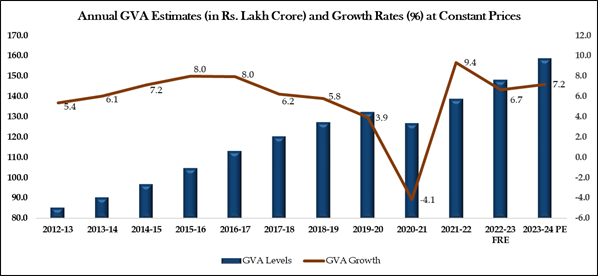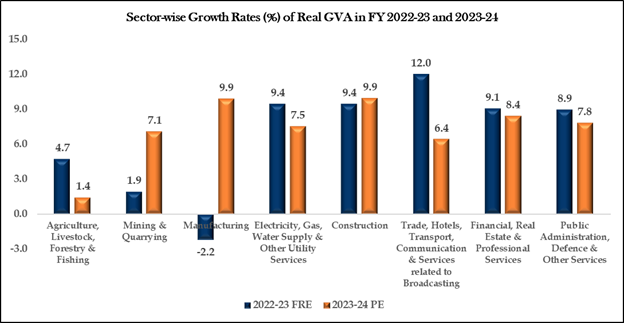- With India’s population skyrocketing (1.4 billion as of October 28, 2024), India faces a significant challenge ahead.
- Goldman Sachs says the country needs to create 10 million jobs each year from 2024 to 2030 to fuel growth.
- Let’s break down how this ambitious job target could unfold.
India’s 10 Million Jobs Challenge
India’s economy is eyeing ambitious growth but there’s a catch.
India needs to create 10 million jobs annually from 2024-25 to 2029-30 just to maintain an average gross value-added (GVA) growth of 6.5% per year, according to a report by Goldman Sachs.
But here’s the thing; it’s going to take India a whole lot of as the figures from the past, didn’t quite match the expectations.
Gross value added (GVA) is a productivity metric that measures the contribution of a corporate subsidiary, company, or municipality to an economy.

Number of jobs created in India over the last 23 years
According to the Goldman Sachs report, titled What is Driving Job Growth? – Navigating through Sectoral Shifts in Indian Labour Markets:
Total Jobs Created (1999-2023): India added approximately 196 million jobs over 23 years.
- Job creation averaged 8.5 million a year from 1999-00 to 2022-23.
- Strong Decade (2012-23): Two-thirds of these jobs came between 2012-13 and 2022-23, with an average of 26 million jobs annually added from 2019-20 to 2022-23,
- Recent uplift: Post-2020, India saw an average addition of 2.4 million jobs per year, largely due to Production Linked Incentive (PLI) schemes introduced in 2020, aimed at boosting high-value manufacturing.
Also read: GCC Market Size In India To Exceed US$100 bn By 2030: Why India Is A Preferred Destination
Sectors responsible for growth
- Agricultural boost: Pandemic-driven migration to rural areas and increased government support spurred job growth in agriculture.
- Services surge: Business services (e.g., consultancy, R&D) and trade (retail, wholesale) led job creation, reflecting a structural shift in employment sectors.
- Manufacturing sector: Manufacturing, traditionally slow on job creation, has shown signs of life recently. Between 2012-13 and 2016-17, manufacturing jobs shrank by 0.2 million annually.
- Chemicals and machinery: Capital-intensive sectors (chemicals, machinery) are outpacing labour-intensive ones (textiles, food & beverages). Labor-intensive sectors like textiles may need more policy attention if they’re to compete with automated, capital-intensive industries.

How can India achieve the 6.5% per year GVA goal?
India’s job creation target of 10 million per year sounds a tad ambitious.
But don’t worry! Goldman Sachs has laid out three focused policies that might help India reach the target:
Affordable social housing development:
- The real estate sector employs 80% of the construction workforce.
- Incentivizing affordable housing can create jobs while addressing the housing deficit.
Expanding IT hubs beyond major cities:
- By moving IT hubs and Global Capability Centers (GCCs) to Tier-2 and Tier-3 cities, resource pressures in major cities can ease while creating new jobs in smaller towns.
Boosting labour-intensive manufacturing:
- Shifting fiscal incentives toward labour-intensive industries, such as textiles and footwear, could diversify job creation beyond capital-heavy sectors.
Also read: India’s GCC revenue $64.6 Billion Up By 40% – Rising opportunities Tax Firms
Goldman’s prediction
Here is Goldman Sachs’ prediction on how the job creation and economic growth might progress in India by 2030.
Base case:
- 10 million jobs annually, maintaining a 6.5% GVA growth rate.
- The real investment rate is expected to rise from 33.5% in FY24 to 36.1% by FY30.
Bull case (Optimistic):
- 7% economic growth, creating 14 million jobs annually.
- The real investment rate could climb to 38.2% by FY30.
Bear case (Pessimistic):
- 6% economic growth, adding only 5 million jobs per year.
- The real investment rate is to hover at 34% by FY30.
Wrapping up
No matter how far-reaching the goal sounds, favourable demographics, strategic policy shifts, and sector-focused incentives could help India attain sustainable growth in the years to come.
Do you think India could transform its economic and employment landscape?
Source: Times Of India














